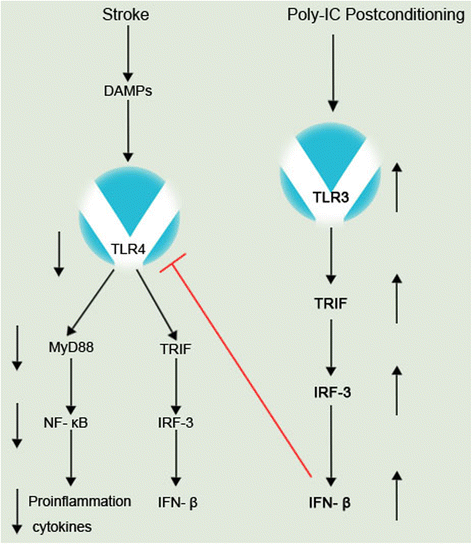Function and mechanism of toll-like receptors in cerebral ischemic tolerance: from preconditioning to treatment
- PMID: 25928750
- PMCID: PMC4422156
- DOI: 10.1186/s12974-015-0301-0
Function and mechanism of toll-like receptors in cerebral ischemic tolerance: from preconditioning to treatment
Abstract
Increasing evidence suggests that toll-like receptors (TLRs) play an important role in cerebral ischemia-reperfusion injury. The endogenous ligands released from ischemic neurons activate the TLR signaling pathway, resulting in the production of a large number of inflammatory cytokines, thereby causing secondary inflammation damage following cerebral ischemia. However, the preconditioning for minor cerebral ischemia or the preconditioning with TLR ligands can reduce cerebral ischemic injury by regulating the TLR signaling pathway following ischemia in brain tissue (mainly, the inhibition of the TLR4/NF-κB signaling pathway and the enhancement of the interferon regulatory factor-dependent signaling), resulting in TLR ischemic tolerance. Additionally, recent studies found that postconditioning with TLR ligands after cerebral ischemia can also reduce ischemic damage through the regulation of the TLR signaling pathway, showing a significant therapeutic effect against cerebral ischemia. These studies suggest that the ischemic tolerance mediated by TLRs can serve as an important target for the prevention and treatment of cerebral ischemia. On the basis of describing the function and mechanism of TLRs in mediating cerebral ischemic damage, this review focuses on the mechanisms of cerebral ischemic tolerance induced by the preconditioning and postconditioning of TLRs and discusses the clinical application of TLRs for ischemic tolerance.
Figures


Similar articles
-
Inhibition of toll-like receptor and cytokine signaling--a unifying theme in ischemic tolerance.J Cereb Blood Flow Metab. 2004 Nov;24(11):1288-304. doi: 10.1097/01.WCB.0000145666.68576.71. J Cereb Blood Flow Metab. 2004. PMID: 15545925 Review.
-
Potential Medications or Compounds Acting on Toll-like Receptors in Cerebral Ischemia.Curr Neuropharmacol. 2018 Jan 30;16(2):160-175. doi: 10.2174/1570159X15666170601125139. Curr Neuropharmacol. 2018. PMID: 28571545 Free PMC article. Review.
-
Preconditioning with recombinant high-mobility group box 1 induces ischemic tolerance in a rat model of focal cerebral ischemia-reperfusion.J Neurochem. 2016 May;137(4):576-88. doi: 10.1111/jnc.13611. Epub 2016 Apr 1. J Neurochem. 2016. PMID: 26991073
-
Toll-like receptors in cerebral ischemic inflammatory injury.J Neuroinflammation. 2011 Oct 8;8:134. doi: 10.1186/1742-2094-8-134. J Neuroinflammation. 2011. PMID: 21982558 Free PMC article. Review.
-
Toll-like receptors and ischemic brain injury.J Neuropathol Exp Neurol. 2014 May;73(5):378-86. doi: 10.1097/NEN.0000000000000068. J Neuropathol Exp Neurol. 2014. PMID: 24709682 Free PMC article. Review.
Cited by
-
Immune Challenges and Seizures: How Do Early Life Insults Influence Epileptogenesis?Front Pharmacol. 2020 Feb 4;11:2. doi: 10.3389/fphar.2020.00002. eCollection 2020. Front Pharmacol. 2020. PMID: 32116690 Free PMC article. Review.
-
Obesity-induced Ly6CHigh and Ly6CLow monocyte subset changes abolish post-ischemic limb conditioning benefits in stroke recovery.J Cereb Blood Flow Metab. 2024 May;44(5):689-701. doi: 10.1177/0271678X231215101. Epub 2023 Nov 16. J Cereb Blood Flow Metab. 2024. PMID: 37974299 Free PMC article.
-
JLX001 Modulated the Inflammatory Reaction and Oxidative Stress in pMCAO Rats via Inhibiting the TLR2/4-NF-κB Signaling Pathway.Neurochem Res. 2019 Aug;44(8):1924-1938. doi: 10.1007/s11064-019-02826-0. Epub 2019 Jun 15. Neurochem Res. 2019. PMID: 31203481
-
The Influence of Mitochondrial-DNA-Driven Inflammation Pathways on Macrophage Polarization: A New Perspective for Targeted Immunometabolic Therapy in Cerebral Ischemia-Reperfusion Injury.Int J Mol Sci. 2021 Dec 23;23(1):135. doi: 10.3390/ijms23010135. Int J Mol Sci. 2021. PMID: 35008558 Free PMC article. Review.
-
Poly-IC Alleviates Nitroglycerin-Induced Migraine by Inhibiting Neuroinflammation via TLR3/TRIF Signaling Pathway.CNS Neurosci Ther. 2025 May;31(5):e70444. doi: 10.1111/cns.70444. CNS Neurosci Ther. 2025. PMID: 40406905 Free PMC article.
References
Publication types
MeSH terms
Substances
LinkOut - more resources
Full Text Sources
Other Literature Sources

